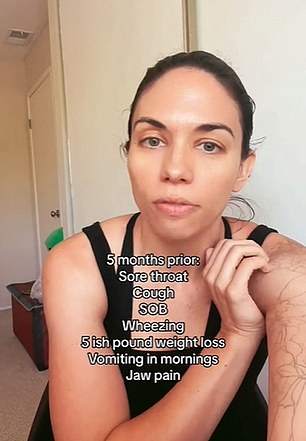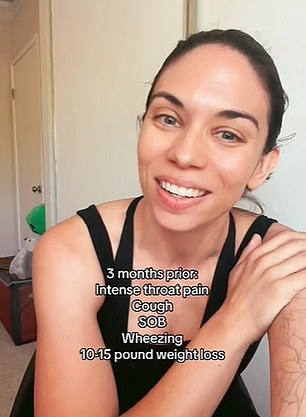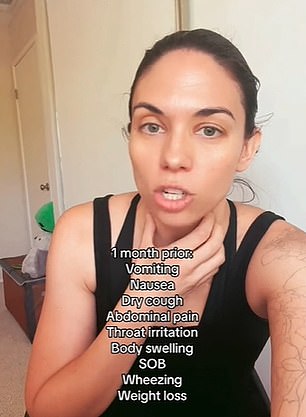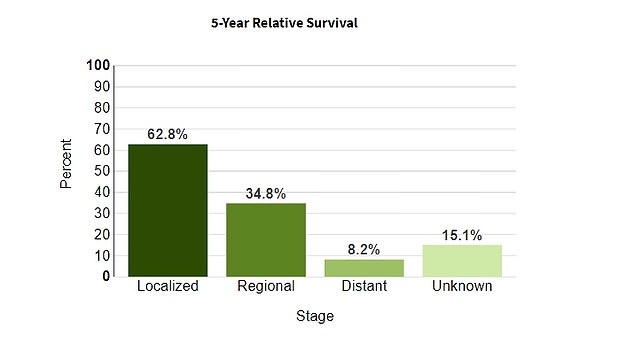Mom, 35, diagnosed with stage 4 lung cancer shares the subtle warning signs she ignored for years
A California mother has revealed that her cancer symptoms were due to anxiety and that doctors told her to “see a therapist.”
Ashley, 35, started experiencing minor signs in 2020 such as difficulty swallowing and sore throat. By the time she was finally diagnosed with lung cancer, the deadliest cancer in the US, her entire body was so swollen she could barely move.
Ashley said she has never smoked and has always been relatively healthy. She regularly ran marathons and competed in martial arts.

Ashley, a 35-year-old California mom, began experiencing symptoms such as difficulty swallowing and fatigue two years before her stage 4 lung cancer diagnosis. By the time she was finally diagnosed, her whole body was so swollen she ‘couldn’t move’

Prior to her diagnosis, Ashley was very physically fit, running marathons and martial arts. A few months before her diagnosis, she had to stop exercising altogether
However, one of her first symptoms was feeling more tired than usual. She also had difficulty swallowing and choked on her food more often.
“My throat just felt weird. I wouldn’t say it was a sore throat, but I drank or drank water. My throat felt a little dry. The food felt different when it went down my throat,” said Ashley.
She attributed these symptoms to the stress caused by the pandemic and her work as a medical social worker.
A year later, Ashley went to the emergency room with a cough and headache, along with her other symptoms, and was only tested for Covid.
As time passed, the coughing became more and more intense.
“It affected me at work. It affected the conversations. I am a fast talker; at that point I found myself having to slow down[and]breathe in between,” she said.
“I went through sachets of cough drops. I probably spent hundreds of dollars on cough drops during that time.”
Ashley started losing weight and wheezing, for which the doctors put her on an inhaler. She was recently divorced, so her medical team thought she was just stressed out.
A few months later, Ashley’s cough became dry and intense. A chest X-ray was normal because the tumor, she later discovered, was hiding behind her heart.


Ashley’s symptoms worsened as time went on, but doctors often turned her away. One doctor suggested she see a therapist to deal with stress

According to the National Cancer Institute (NCI), lung cancer is the deadliest cancer in the US. The survival rate drops significantly as it spreads. Distant lung cancer has only a five-year survival rate of 8.2 percent
“If they had ordered a CT or PET scan for me, it would have showed up on that,” she said.
She continued to lose weight and started vomiting in the morning. With an inhaler in hand, she ran a half marathon, although it took her considerably longer than usual.
Her average time was about two hours, and she estimates that this event lasted at least three and a half to four hours.
“I probably went through an entire inhaler during that half marathon,” she said.
Because Ashley was running a half marathon, the doctors said it couldn’t be lung cancer.
“They said, ‘It’s all stress. You’re going through a divorce, you work in healthcare, there’s a pandemic, you have young children. Maybe see a therapist,” she said.
“I could barely swallow at this point. It felt like there was nothing but kibble in my throat.’
Normally physically active, Ashley had to stop exercising and had lost 10 to 15 pounds. Doctors eventually diagnosed pneumonia.
Then her whole body swelled up.
“I couldn’t put my shoes on and pick up my kids,” she said.
“I couldn’t move at all.”
Although she continued to search for doctors and took herself to the emergency room, the doctors continued to send Ashley away.
In the end, her friend insisted she go to the emergency room and not leave until she got a response.
“This saved my life,” she said.
Doctors found blood clots in one leg and one lung,
Doctors found blood clots in her leg and another in her right lung, then discovered stage 4 non-small cell lung cancer.
Lung cancer is the deadliest form of cancer in the US, according to the American newspaper National Cancer Institute (NCI). It is responsible for one in five cancer deaths, followed by colorectal cancer, which accounts for one in ten cancer deaths.
It is also usually diagnosed after it has already spread to other areas. About 53 percent of cases are considered distant, meaning they have traveled to multiple other organs.
The survival rate also drops significantly in these cases. Distant lung cancer has only a five-year survival rate of 8.2 percent.
Only one in four lung cancer patients survives after five years.
There are two main types of lung cancer: small cell and non-small cell.
Non-small cell is the most common, accounting for nine out of ten lung cancer diagnoses, and tends to grow more slowly. It usually doesn’t cause any symptoms until it’s advanced.
The United States Preventative Services Task Force (USPSTF) recommends screening for lung cancer only for adults ages 50 to 80 who have smoked 20 packs of cigarettes per year or have quit within the past 15 years.
“It turns out that if I hadn’t started treatment, I would have had less than five months to live,” Ashley said.
“I’m very thankful that I had people around me who listened to me and loved me, because my life depended on it.”
Ashley has since had one of her lungs removed and is undergoing an eight-month course of chemotherapy, radiation and immunotherapy.
